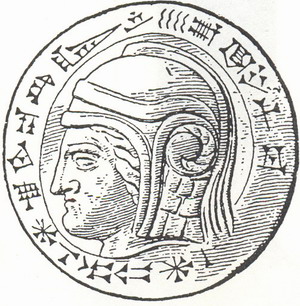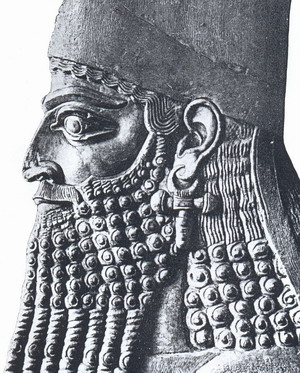and the Babylonians (7 March 2017, 9 Adar, 5777)
Contents:
1. Question
2. What was Babylon? Sumer and Shinar Today?
3. Babylon in the Bible
4. The Babylonian Peoples
5. Present-Day Descendants
^^^^^^^^^^^^^^^^^^^^^^^^^^^^^^^^^^^^^^^^^^^^^^^^^^
1. Question
Yair what did the Babylonians look like? What family are they from, Shem, Japheth, Ham? Did they mix in well with Isreal?
Thx, Mike
^^^^^^^^^^^^^^^^^^^^^^^^^^^^^^^^^^^^^^^^^^^^^^^^^^
2. What was Babylon? Sumer and Shinar Today?
Babylon is a city in Mesopotamia i.e. the Land Between the Rivers in present-day Iraq.
The Babylonians considered themselves a continuation of Sumerian civilization. Ancient Sumer is known as "Shinar" in Biblical Hebrew (Genesis 10:10).
Shinar is one of the regions the Israelites of the Ten Tribes and Judah will return from (Isaiah 11:11).
The term "Shinar" in Prophecy may refer to:
a. Present-day Iraq, see:
The Return of Ephraim. Ephraim Comes Back!
The USA in Iraq: Has the Return of the Lost Ten Tribes Began?
http://britam.org/USAMatsor.html
b. Present-day north-east Turkey (ca. Sinope) which was also know later as "Shinar."
c. Some other area to which the peoples of Babylon and Shinar migrated.
The Babylonians were neighbors to Akkad from whom emerged the Assyrians. Babylonians and Assyrians overlapped and in many ways intermerged with each other.
^^^^^^^^^^^^^^^^^^^^^^^^^^^^^^^^^^^^^^^^^^^^^^^^^^
3. Babylon in the Bible
Babylon the city was founded by Nimrod the son of Ham son of Noah (Genesis 10:8-10).
Babylon was the scene of the Tower of Babel ( Gen. 11 ). This was where the initial universal language (probably Hebrew) was confused and all the different languages of the earth began. In Hebrew "Babel" (from which the name Babylon may derive) means "confused, i.e. "babble."
The Euphrates River flowed through Babylon about 200 miles of its junction with the Tigris River.
The Assyrians exiled the northern Ten Tribes in ca. 730-720 BCE according to conventional chronology. Only the Jews of Judah remained.
In ca. 586 BCE the Babylonians destroyed the First Temple and exiled the Jews of Judah to Babylon.
After seventy years the Jews were allowed to return. A return was made though at the beginning most Jews remained in Exile. This was the beginning of the Second Temple Period.
The Prophets frequently condemned Babylon and predicted its destruction (.e.g. Isaiah 13:19, 47:5, Jeremiah 25;12, 50:2, 51:37, Daniel 2:31-38, Psalm 137:8=9.
Babylon is associated with the people known as Chasdim [pronounced more like Hasdim] which name for some reason is translated as Chaldean in conventional translations.
Chesed was the ancestor of the Chasdim (pronounced more like Hasdim) otherwise known as the Chaldeans. These were descended from Nahor who was a brother of Abraham (Genesis 22:22).
Babylon became equated with Edom (Psalm 137:7-8). In both Jewish and later Christian tradition Babylon also became equated with Rome.
^^^^^^^^^^^^^^^^^^^^^^^^^^^^^^^^^^^^^^^^^^^^^^^^^^
4. The Babylonian Peoples
 The Babylonians were mixed. Many may have had blue eyes judging by the use of lapiz lazuli for the eyes in statues etc.
The Babylonians emerged from the Sumerians of Shinar. The common people of Sumer are depicted as having long English-type head shapes with large eyes, upturned Irish type noses or bleakish-type ones.
They referred to themselves as "the black-haired race."
Mordecai Lapid of Kiryat Araba reported that according to Soviet studies the ruling class of Sumer were a bit different with roundish Alpine type heads as in Central Europe and amongst the Slavs.
Hair color was probably darkish.
They may have looked much like modern Italians. Many Italians are indeed descended from them.
See Ernest L. Martin, "The People That History Forgot ."
The Babylonians may have intermixed with mainly white Hamites but in principle they were descended from the Semitic Chaldeans (Casdim) and were distant relatives of Abraham.
There is a picture that may be genuine of the Babylonian monarch Nebuchadnessar. He has a square Germanic type head.

See:
Pictures of Pagan Monarchs who Exiled Israelites
http://britam.org/HebrewTypes3.html#Pagan
As mentioned Babylon was often associated with Assyria. The Assyrians kings are usually depicted as having pale skin, dark eyes, and dark curly hair, thick lips, and largish slightly hooked noses. They have large, round protruding "Jewish"-type eyes, and thick muscular bodies.

The Guti were subjects of the Assyrians and their name has been explained as meaning "blond."
It is hard to say how much intermixture with Israelites or Judeans took place.
The records do not mention it as far as I know.
^^^^^^^^^^^^^^^^^^^^^^^^^^^^^^^^^^^^^^^^^^^^^^^^^^
5. Present-Day Descendants
The Peoples of Iraq, the Kurds, Armenians, Yezdis, etc, may in part be descended from the ancient Babylonians.
We have noted a possible connection with Italy and Central Europe.
The Samaritans in Israel were non-Israelite colonists whom the Assyrians settled in the former land of Israel (2-Kings 17:25-28)Â .
The Samaritans are descended in large part from people who later comprised the Babylonian Empire.
Some of them are blue eyed, some red-haired. Most are light skinned but darkish and "Middle Eastern" looking.
The Samaritans however have been intermarrying with themselves for centuries.
Due to Genetic drift etc the dominant features at present may be different from what they originally were.
See:
THE SAMARITANS. Do traditions of British and French Kinship Reflect Ancestral Connections?
http://www.britam.org/samaritans.html
